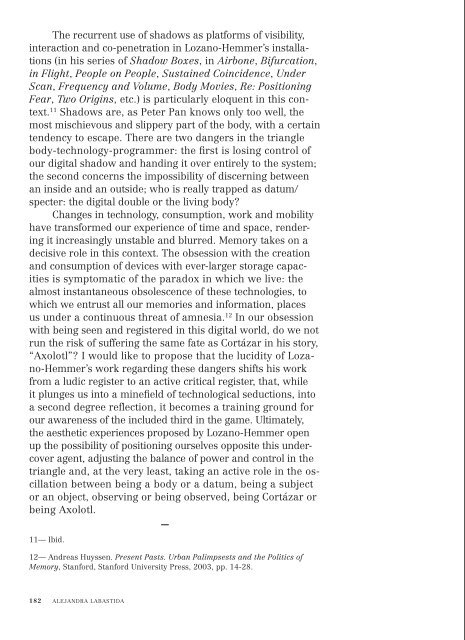Create successful ePaper yourself
Turn your PDF publications into a flip-book with our unique Google optimized e-Paper software.
The recurrent use of shadows as platforms of visibility,<br />
interaction and co-penetration in Lozano-Hemmer’s installations<br />
(in his series of Shadow Boxes, in Airbone, Bifurcation,<br />
in Flight, People on People, Sustained Coincidence, Under<br />
Scan, Frequency and Volume, Body Movies, Re: Positioning<br />
Fear, Two Origins, etc.) is particularly eloquent in this context.<br />
11 Shadows are, as Peter Pan knows only too well, the<br />
most mischievous and slippery part of the body, with a certain<br />
tendency to escape. There are two dangers in the triangle<br />
body-technology-programmer: the first is losing control of<br />
our digital shadow and handing it over entirely to the system;<br />
the second concerns the impossibility of discerning between<br />
an inside and an outside; who is really trapped as datum/<br />
specter: the digital double or the living body?<br />
Changes in technology, consumption, work and mobility<br />
have transformed our experience of time and space, rendering<br />
it increasingly unstable and blurred. Memory takes on a<br />
decisive role in this context. The obsession with the creation<br />
and consumption of devices with ever-larger storage capacities<br />
is symptomatic of the paradox in which we live: the<br />
almost instantaneous obsolescence of these technologies, to<br />
which we entrust all our memories and information, places<br />
us under a continuous threat of amnesia. 12 In our obsession<br />
with being seen and registered in this digital world, do we not<br />
run the risk of suffering the same fate as Cortázar in his story,<br />
“Axolotl”? I would like to propose that the lucidity of Lozano-Hemmer’s<br />
work regarding these dangers shifts his work<br />
from a ludic register to an active critical register, that, while<br />
it plunges us into a minefield of technological seductions, into<br />
a second degree reflection, it becomes a training ground for<br />
our awareness of the included third in the game. Ultimately,<br />
the aesthetic experiences proposed by Lozano-Hemmer open<br />
up the possibility of positioning ourselves opposite this undercover<br />
agent, adjusting the balance of power and control in the<br />
triangle and, at the very least, taking an active role in the oscillation<br />
between being a body or a datum, being a subject<br />
or an object, observing or being observed, being Cortázar or<br />
being Axolotl.<br />
11— Ibid.<br />
12— Andreas Huyssen. Present Pasts. Urban Palimpsests and the Politics of<br />
Memory, Stanford, Stanford University Press, 2003, pp. 14-28.<br />
182<br />
ALEJANDRA LABASTIDA<br />
Antimodular Research, Estudio de Lozano-Hemmer, vista general—Lozano-Hemmer's Studio, general view 183


